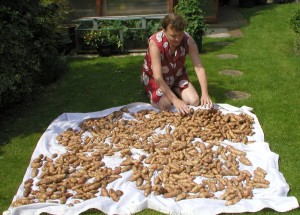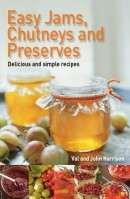Having harvested your next job is to sort your potatoes out. The best potatoes for storing are perfect, no holes or wounds from the fork when harvesting. The pile that have small holes where a slug or insect has got in or damaged will not store as well so they go into a ‘use first’ bag.
The best thing for storing potatoes in is a hessian sack (burlap bag). These can be bought quite cheaply from garden and seed potato suppliers.
The reason is that the potatoes in store will release moisture and the sacking material allows them to breathe whilst excluding light.
Green Potatoes
Light will, over time, cause your potatoes to turn green and the green potatoes contains alkaloid chemicals, solanine and chaconine which are poisonous.
Remember potatoes are part of the same family as deadly nightshade. I don’t want to scare you though, eating a whole meal of green potatoes is most likely to just cause you a stomach ache, but that’s best avoided anyway.
If you find some of your potatoes are more than a third green at harvest discard them. Less than a third green are worth keeping as they will lose the green if kept in absolute darkness. You should cut away any green in skin or flesh you find when preparing for a meal.
If you don’t have a hessian sack available then you can try paper sacks. A friendly chip shop may well give you some for the asking. They’re not ideal for our purpose but will do in a pinch. We’ve also used old pillowcases as potato sacks.When using last year’s hessian sacks, especially if you’ve had some blight or rot in the sack, it’s a good idea to give them a wash. They tend to shed so perhaps not in the washing machine. A bath full of hot soapy water with just a splash of bleach will sterilise them adequately for another year.
Never, ever, store potatoes in plastic bags and especially not in transparent or white ones. Not only will light get through but moisture will not escape and your potatoes will rot quite quickly.
I used to suggest that “when the potatoes are placed into the sack, it’s a good idea to drop a few slug pellets in. It’s surprising how many times you miss a little hole in a ‘perfect’ potato and a slug is inside the hole. Not only will he eat that potato but he’s bound to creep out to damage a few others. Slug pellets contain an attracter which entices them out to eat them and stops further damage. The potatoes will be perfectly safe and there is no danger to pets or wildlife as the pellets are in the sack”
However it was pointed out that this hasn’t been safety tested and could be a misuse of a pesticide so now I don’t promote it in my British works. LOL
Check Your Stored Potatoes
It’s a good idea to empty out the sack after a month and check that none of the potatoes are rotting in storage. In a bad blight year there is bound to be one that has got through and blight spreads very easily from one to the other in store. If you are unsure of a potato, smell it. Blight has a very distinctive unpleasant smell that you cannot confuse with anything else.
Flies Spot Rotting Potatoes
One year when we were checking over our potatoes before bagging them, we noticed that flies were attracted to potatoes that appeared perfect to the eye. These turned out to have soft spots starting to rot and the flies knew which ones were starting to rot from the smell.
Correct Temperature for Storing Potatoes
Below 5°C the starch begins to turn to sugars and the potatoes will develop an unpleasant strange sweetish taste. Bringing them into the warm (around 15°C) for a week or two will usually cure this. If the temperature has fallen around freezing or below, the potatoes will not only taste strange but become mushy and probably start to rot when the temperature rises.
Freezing Potatoes
If you have damaged potatoes that you know you will not be able to use before they go off, then you can freeze them. You can’t freeze them just as potatoes but you can make things like duchess potatoes, croquet potatoes or chips and freeze them. Ordinary mashed potato can be frozen, just make as normal and shape into patties. Freeze the patties and store in an airtight bag until required. Be aware the texture isn’t quite the same and they often seem watery so use as a topping for dishes like shepherd’s pie and bake in an oven until browned on the top.
More on Harvesting & Storing Your Crops
- How & Where to Store your Produce
- Harvesting & Storing Onions, Garlic & Shallots
- Storing root crops, cabbages & cauliflowers, marrows & squash
- Harvesting Potatoes Guide



